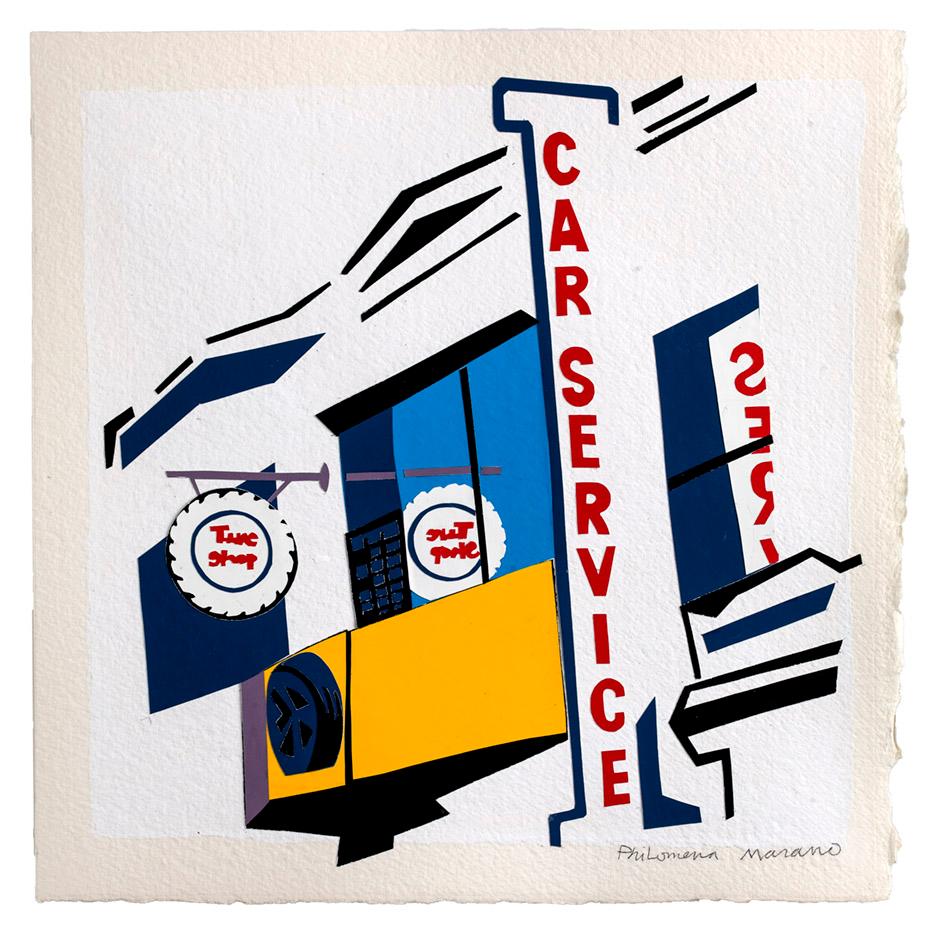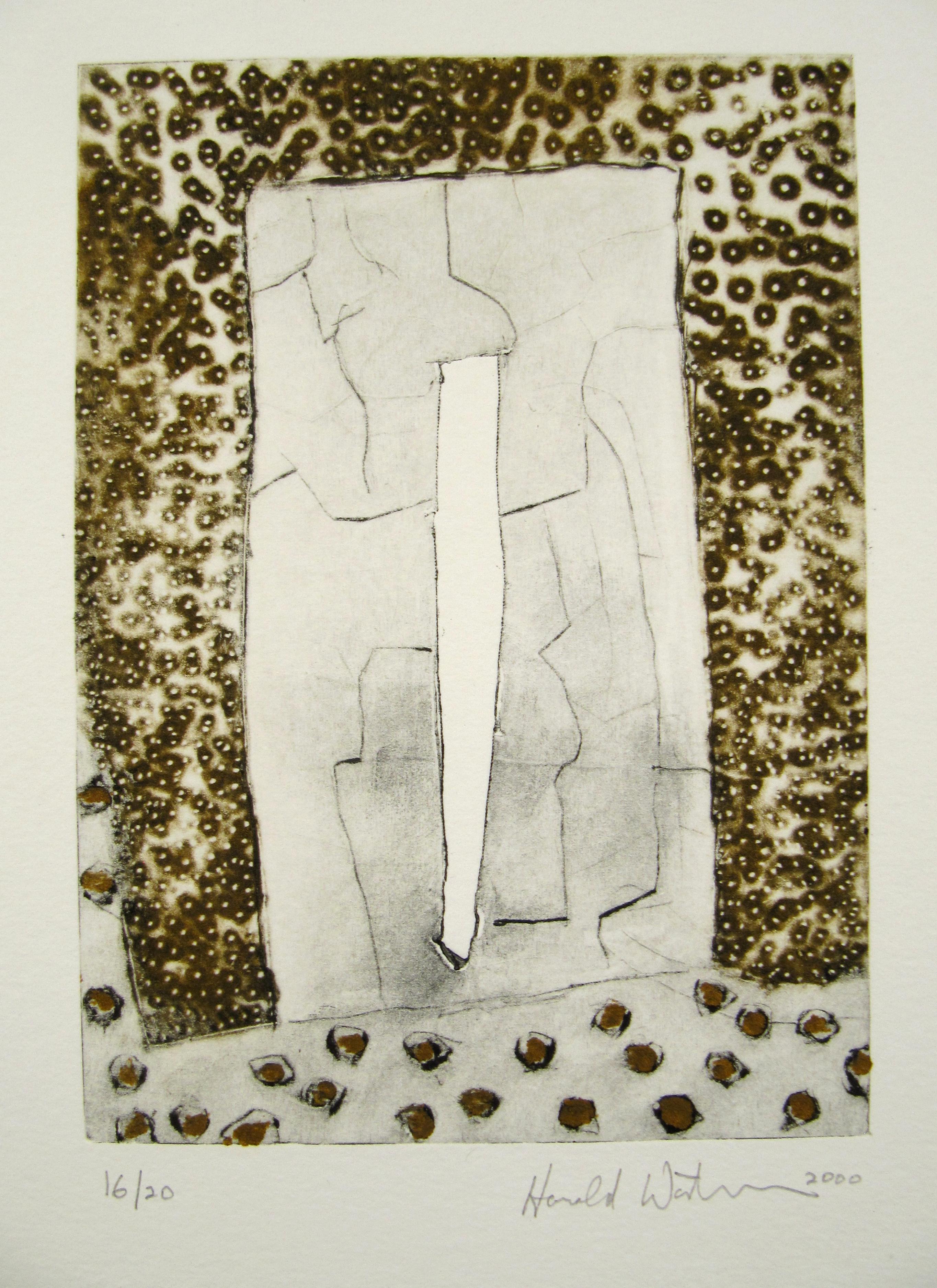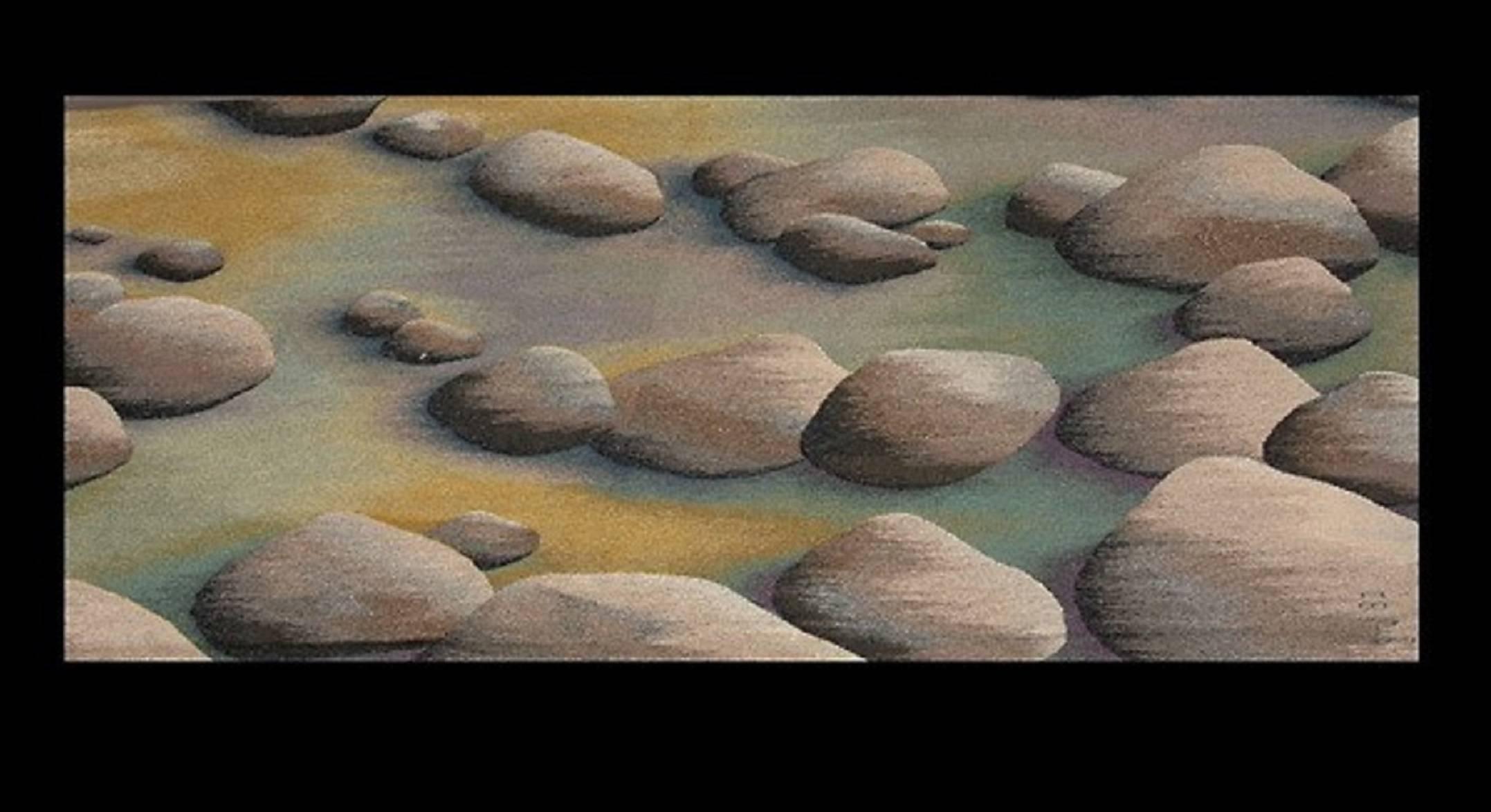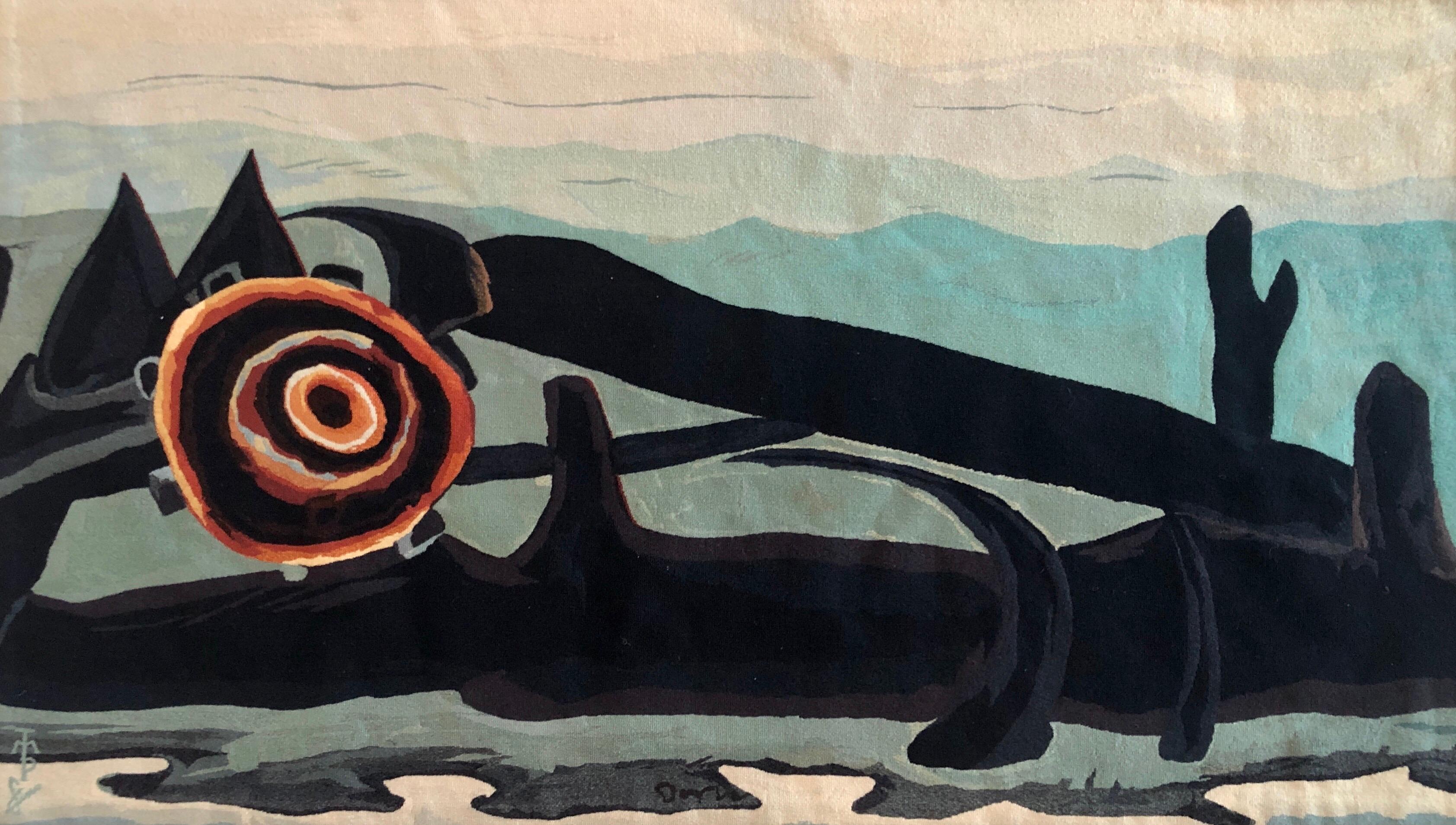Items Similar to Cossack Dancers
Want more images or videos?
Request additional images or videos from the seller
1 of 3
Wilhelm Hunt DiederichCossack Dancers c. 1920
c. 1920
About the Item
Wilhelm Hunt Diederich, 'Cossack Dancers', cut paper silhouette, c. 1920. Signed 'WHD' in pencil, lower left image.
Black, wove, cut paper, laid on crimson tissue background, spot glued in the top left and right sheet corners to the original mount. The mount with margins (7/8 to 1 1/2 inches). Toning at the glue spots; gentle rippling in the background tissue, otherwise in good condition. Matted to museum standards, unframed.
Provenance: Clayton Liberatore Gallery, acquired directly from the artist.
- Creator:Wilhelm Hunt Diederich (1884 - 1953, Hungarian)
- Creation Year:c. 1920
- Dimensions:Height: 7.5 in (19.05 cm)Width: 13.38 in (33.99 cm)
- Medium:
- Movement & Style:
- Period:
- Condition:Rippling...
- Gallery Location:Myrtle Beach, SC
- Reference Number:
About the Seller
5.0
Recognized Seller
These prestigious sellers are industry leaders and represent the highest echelon for item quality and design.
Platinum Seller
These expertly vetted sellers are 1stDibs' most experienced sellers and are rated highest by our customers.
Established in 1995
1stDibs seller since 2016
258 sales on 1stDibs
Typical response time: 1 hour
Associations
International Fine Print Dealers Association
- ShippingRetrieving quote...Ships From: Myrtle Beach, SC
- Return PolicyA return for this item may be initiated within 7 days of delivery.
More From This SellerView All
- 'Navajo Horse Race' — 1940s Southwest RegionalismBy Ira MoskowitzLocated in Myrtle Beach, SCIra Moskowitz, 'Navajo Horse Race', lithograph, 1946, edition 30, Czestochowski 204. Signed and titled in pencil. Signed and dated in the stone, lower le...Category
1940s American Modern Landscape Prints
MaterialsLithograph
- 'Navajo Trading Post' — 1940s Southwest RegionalismBy Ira MoskowitzLocated in Myrtle Beach, SCIra Moskowitz, 'Navajo Trading Post', lithograph, 1946, edition 30, Czestochowski 161. Signed and dated in the stone, lower left. A fine, richly-inked impression, on cream wove paper, with full margins (1 1/2 to 3 1/8 inches). Pale mat line, otherwise in excellent condition. Matted to museum standards, unframed. Image size 11 11/16 x 15 1/2 inches (297 x 395 mm); sheet size 16 5/16 x 191/8 inches (414 x 486 mm). ABOUT THE ARTIST Ira Moskowitz was born in Galicia, Poland, in 1912, emigrating with his family to New York in 1927. He enrolled at the Art Student's League and studied there from 1928-31. In 1935, Moskowitz traveled to Paris and then lived until 1937 in what is now Israel. He returned to the United States in 1938 to marry artist Anna Barry in New York. The couple soon visited Taos and Santa Fe in New Mexico, returning for extended periods until 1944, when they moved there permanently, staying until 1949. During this especially productive New Mexico period, Moskowitz received a Guggenheim fellowship. His work was inspired by the New Mexico landscape and the state’s three cultures (American Southwest, Native American, and Mexican). He focused on Pueblo and Navajo life, producing an extensive oeuvre of authentic American Indian imagery. He and Anna also visited and sketched across the border in Old Mexico. While in the Southwest, Moskowitz flourished as a printmaker while continuing to produce oils and watercolors. Over 100 of Moskowitz’s works depicting Native American ceremonies were used to illustrate the book American Indian Ceremonial Dances by John Collier, Crown Publishers, New York, 1972. After leaving the Southwest, printmaking remained an essential medium for the artist while his focus changed to subject matter celebrating Judaic religious life and customs. These works were well received early on, and Moskowitz was content to stay with them the rest of his life. From 1963 until 1966, Moskowitz lived in Paris, returning to New York City in 1967, where he made his permanent home until he died in 2001. Shortly before his death, Zaplin-Lampert Gallery of Santa Fe staged an exhibition of the artist's works, December 2000 - January 2001. Other one-person shows included the 8th Street Playhouse, New York, 1934; Houston Museum, 1941; and the San Antonio Museum, 1941. The artist’s work was included in exhibitions at the Art Students League, Art Institute of Chicago, Philadelphia Print Club, College Art Association (promotes excellence in scholarship and teaching), and the International Exhibition of Graphic Arts (shown at MOMA, 1955). Moskowitz’s lithographs of American Indian...Category
1940s American Modern Landscape Prints
MaterialsLithograph
- 'Woolworth Building Under Construction' — Early 20th Century ModernismBy Earl HorterLocated in Myrtle Beach, SCEarl Horter, 'The Woolworth Building Under Construction', etching, c. 1912, edition not stated. Signed in pencil. A fine, richly-inked impression, in warm black ink, with selectively...Category
1910s American Modern Landscape Prints
MaterialsEtching
- 'Navajo Courtship Dance' — 1940s Southwest RegionalismBy Ira MoskowitzLocated in Myrtle Beach, SCIra Moskowitz, 'Navajo Courtship Dance (Squaw Dance)', lithograph, 1946, edition 30, Czestochowski 161. Signed and titled in pencil. Signed and dated in the stone, lower left. A fine, richly-inked impression, on cream wove paper; the full sheet with margins (7/16 to 2 3/4 inches). Pale mat line, otherwise in excellent condition. Matted to museum standards, unframed. Image size 11 13/16 x 14 13/16 inches (300 x 376 mm); sheet size 13 1/16 x 20 1/8 inches (332 x 511 mm). ABOUT THE ARTIST Ira Moskowitz was born in Galicia, Poland, in 1912, emigrating with his family to New York in 1927. He enrolled at the Art Student's League and studied there from 1928-31. In 1935, Moskowitz traveled to Paris and then lived until 1937 in what is now Israel. He returned to the United States in 1938 to marry artist Anna Barry in New York. The couple soon visited Taos and Santa Fe in New Mexico, returning for extended periods until 1944, when they moved there permanently, staying until 1949. During this especially productive New Mexico period, Moskowitz received a Guggenheim fellowship. His work was inspired by the New Mexico landscape and the state’s three cultures (American Southwest, Native American, and Mexican). He focused on Pueblo and Navajo life, producing an extensive oeuvre of authentic American Indian imagery. He and Anna also visited and sketched across the border in Old Mexico. While in the Southwest, Moskowitz flourished as a printmaker while continuing to produce oils and watercolors. Over 100 of Moskowitz’s works depicting Native American ceremonies were used to illustrate the book American Indian Ceremonial Dances by John Collier, Crown Publishers, New York, 1972. After leaving the Southwest, printmaking remained an essential medium for the artist while his focus changed to subject matter celebrating Judaic religious life and customs. These works were well received early on, and Moskowitz was content to stay with them the rest of his life. From 1963 until 1966, Moskowitz lived in Paris, returning to New York City in 1967, where he made his permanent home until he died in 2001. Shortly before his death, Zaplin-Lampert Gallery of Santa Fe staged an exhibition of the artist's works, December 2000 - January 2001. Other one-person shows included the 8th Street Playhouse, New York, 1934; Houston Museum, 1941; and the San Antonio Museum, 1941. The artist’s work was included in exhibitions at the Art Students League, Art Institute of Chicago, Philadelphia Print Club, College Art Association (promotes excellence in scholarship and teaching), and the International Exhibition of Graphic Arts (shown at MOMA, 1955). Moskowitz’s lithographs of...Category
1940s American Modern Landscape Prints
MaterialsLithograph
- 'Navajo Medicine Ceremony of the Night Chant' — 1940s Southwest RegionalismBy Ira MoskowitzLocated in Myrtle Beach, SCIra Moskowitz, 'The Three Gods of Healing (Navajo Medicine Ceremony of the Night Chant)', lithograph, 1945, edition 30, Czestochowski 148. Signed and titled in pencil. Signed and dated in the stone, lower right. A fine, richly-inked impression, on cream wove paper, with full margins (2 1/4 to 2 3/4 inches), in excellent condition. Matted to museum standards, unframed. Image size 12 1/4 x 15 13/16 inches (311 x 402 mm); sheet size 17 1/8 x 20 7/8 inches (435 x 530 mm). ABOUT THIS WORK The nine-night ceremony known as the Night Chant or Nightway is believed to date from around 1000 B.C.E. when it was first performed by the Indians who lived in Canyon de Chelly (now eastern Arizona). It is considered the most sacred of all Navajo ceremonies and one of the most difficult and demanding to learn, as it encompasses hundreds of songs, dozens of prayers, and several highly complex sand paintings. And yet the demand for Night Chants is so great that as many as fifty such ceremonies might be held during a single winter season, which lasts eighteen to twenty weeks. The Night Chant is designed both to cure people who are ill and to restore the order and balance of human and non-human relationships within the Navajo universe. Led by a trained medicine man who has served a long apprenticeship and learned the intricate and detailed practices that are essential to the chant, the ceremony itself is capable of scaring off sickness and ugliness through techniques that shock or arouse. Once the disorder has been removed, order and balance are restored through song, prayer, sand painting, and other aspects of the ceremony. The medicine men who supervise the Night Chant ensure that everything—each dot and line in every sand painting, each verse in every song, each feather on each mask is arranged precisely, or it will not bring about the desired result. There are probably as many active Night Chant medicine men today as at any time in Navajo history due to the general increase in the Navajo population, the popularity of the ceremony, and the central role it plays in Navajo life and health. ABOUT THE ARTIST Ira Moskowitz was born in Galicia, Poland, in 1912, emigrating with his family to New York in 1927. He enrolled at the Art Student's League and studied there from 1928-31. In 1935, Moskowitz traveled to Paris and then lived until 1937 in what is now Israel. He returned to the United States in 1938 to marry artist Anna Barry in New York. The couple soon visited Taos and Santa Fe in New Mexico, returning for extended periods until 1944, when they moved there permanently, staying until 1949. During this especially productive New Mexico period, Moskowitz received a Guggenheim fellowship. His work was inspired by the New Mexico landscape and the state’s three cultures (American Southwest, Native American, and Mexican). He focused on Pueblo and Navajo life, producing an extensive oeuvre of authentic American Indian imagery. He and Anna also visited and sketched across the border in Old Mexico. While in the Southwest, Moskowitz flourished as a printmaker while continuing to produce oils and watercolors. Over 100 of Moskowitz’s works depicting Native American ceremonies were used to illustrate the book American Indian Ceremonial Dances by John Collier, Crown Publishers, New York, 1972. After leaving the Southwest, printmaking remained an essential medium for the artist while his focus changed to subject matter celebrating Judaic religious life and customs. These works were well received early on, and Moskowitz was content to stay with them the rest of his life. From 1963 until 1966, Moskowitz lived in Paris, returning to New York City in 1967, where he made his permanent home until he died in 2001. Shortly before his death, Zaplin-Lampert Gallery of Santa Fe staged an exhibition of the artist's works, December 2000 - January 2001. Other one-person shows included the 8th Street Playhouse, New York, 1934; Houston Museum, 1941; and the San Antonio Museum, 1941. The artist’s work was included in exhibitions at the Art Students League, Art Institute of Chicago, Philadelphia Print Club, College Art Association (promotes excellence in scholarship and teaching), and the International Exhibition of Graphic Arts (shown at MOMA, 1955). Moskowitz’s lithographs of...Category
1940s American Modern Landscape Prints
MaterialsLithograph
- 'African Idol' — 1930s American ModernismBy Robert Vale FaroLocated in Myrtle Beach, SCRobert Vale Faro, untitled (African Idol), serigraph, c. 1940, edition 6. Signed in pencil. A fine impression, with fresh colors, on buff wove paper; the full sheet with margins(5/8 ...Category
1940s American Modern Abstract Prints
MaterialsScreen
You May Also Like
- Car Service, cut paper collage, urban landscape, hard edge, bold graphic, textBy Philomena MaranoLocated in Brooklyn, NYCAR SERVICE Hand cut paper on heavy weight gessoed watercolor paper, framed in flat gray painted wood & plexi. Ms. Marano is a daughter of Brooklyn. She holds a BFA from Pratt Institute, is an intimate of the visual poetry of Coney Island, created the winning poster for the first Spirit of Brooklyn poster...Category
Early 2000s American Modern Mixed Media
MaterialsPaper
- Harold Wortsmann (USA, 1950) - Limited Colored Engraving 16/20 - Time HoleBy Harold WortsmanLocated in Meinisberg, CHHarold Wortsmann (American, *1950) Time Hole • Colored Engraving • Sheet ca. 28.5 x 25.5 cm • Signed, dated 2000 & limited 16/20 • Blindstamp bottom left corner • Inscribed v...Category
Early 2000s American Modern Abstract Prints
MaterialsPaper, Engraving
- Very Large Hand Woven Wool Tapestry "Boulders II" River StonesBy Julia MitchellLocated in Surfside, FLJulia Mitchell Wool on Linen Tapestry, Boulders II Signed and dated JM 82 Julia Mitchell’s Biography Julia grew up in a family of artists, adopting tap...Category
20th Century American Modern More Art
MaterialsWool, Linen
- Handmade Wool Tapestry Abstract American Modernist Arthur Dove Aubusson StyleLocated in Surfside, FLOriginal hand made, hand woven wall hanging modern art tapestry. Manufactura de Tapecarias de Portalegre (Portugal) (TMP Fino) tapestries ar...Category
20th Century American Modern Landscape Paintings
MaterialsWool
- Jazz PlayersLocated in Missouri, MOJazz Players by Bill Hinz (1920-2009) Signature in Textile Bottom Left Unframed: 41.5" x 64" Framed: 42.5" x 64.75" Unique Piece made entirely out of a s...Category
20th Century American Modern More Art
MaterialsTextile
- Beautiful ChaosBy Angele LaSalleLocated in East Hampton, NYDistressed Abstract Painting Artist Statement: Painting has been a powerful medium for expressing my emotions. Through my art, I am able to escape, dream, hope, remain calm in the m...Category
2010s American Modern Abstract Paintings
MaterialsCanvas, Acrylic





